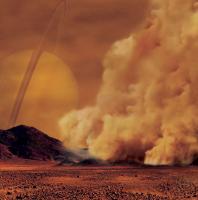Printable Version of Topic
Click here to view this topic in its original format
Unmanned Spaceflight.com _ Titan _ Dust Storms on Titan
Posted by: wildespace Sep 25 2018, 03:08 PM
Dust storms on Titan spotted for the first time: https://solarsystem.nasa.gov/news/543/dust-storms-on-titan-spotted-for-the-first-time/.
It seems like the dust and "sand" from the hydrocarbon dunes at the equator can be kicked up by strong winds, which would then transport it over great distances.
Question regarding the above illustration: would Saturn be at all visible from Titan's surface? I was under the impression that Titan's atmosphere is completely opaque.
Posted by: Phil Stooke Sep 25 2018, 05:06 PM
I don't know if the atmosphere is completely opaque in visible wavelengths, but if a bit of light can get through, the contrast of Saturn against black space would show up a lot better than small variations in shading looking downwards at Titan from above. In some IR wavelenths we can see the surface from above, so certainly at those wavelengths Saturn could be seen.
Phil
Posted by: ngunn Sep 25 2018, 08:15 PM
I seem to recall from earlier discussions that a sharp reddish image of the sun is believed to be faintly visible from the surface when it is at high elevation, but not near the horizon. Presumably the same would be true of Saturn at night. I would be very surprised if Saturn were visible at all by day however, even overhead.
Posted by: vjkane Sep 26 2018, 02:47 AM
I wonder how this will affect the Dragonfly evaluation.
Posted by: marsbug Oct 17 2019, 05:24 PM
A paper in Science raises two intriguing ideas. The first is scientific: The hydrocarbon dunes may be 'grown' from hydrocarbon ices undergoing a yet-to-be-fully-pinned-down reaction powered by cosmic rays. That could also explain their presence on airless solar system bodies. https://advances.sciencemag.org/content/5/10/eaaw5841
The second is... artistic: According to Michael Malaska, who studies planetary ices at NASA's Jet Propulsion Laboratory in California. "Their work further supports that some of Titan's sand may glow pretty colors under UV light," That was reported in https://www.space.com/saturn-moon-titan-dunes-carbon-compound-formation.html: Bring a powerful blacklight to a dust storm on Titan and your might get some mind-blowing visuals.
Posted by: rlorenz Oct 22 2019, 09:37 PM
Yes, I pointed out at the Planetary Dunes workshop a couple of years ago that the sands on Titan likely contain PAHs which may fluoresce (see attached abstract)
Dragonfly carries UV illuminators and will take pictures of the sand at night to look for this.
Posted by: ngunn Oct 23 2019, 08:49 AM
Fascinating stuff, thanks for posting the link. It certainly sets the imagination going. I wonder if material suspended in Titan's surface liquids might fluoresce also, perhaps in response to fluvial, tidal or wave motion?
Posted by: JRehling Oct 23 2019, 11:12 PM
Fluorescence is due to higher-energy/shorter-wavelength photons being downshifted to >1 photons at lower energy being absorbed. There is also triboluminescence caused by high physical stress on solids, which you can see by biting into mint Lifesavers in a dark room (they flash, softly). I don't think tides or waves would generate sufficient force to do that, but I also wouldn't count on Titan failing to surprise us.
Powered by Invision Power Board (http://www.invisionboard.com)
© Invision Power Services (http://www.invisionpower.com)


